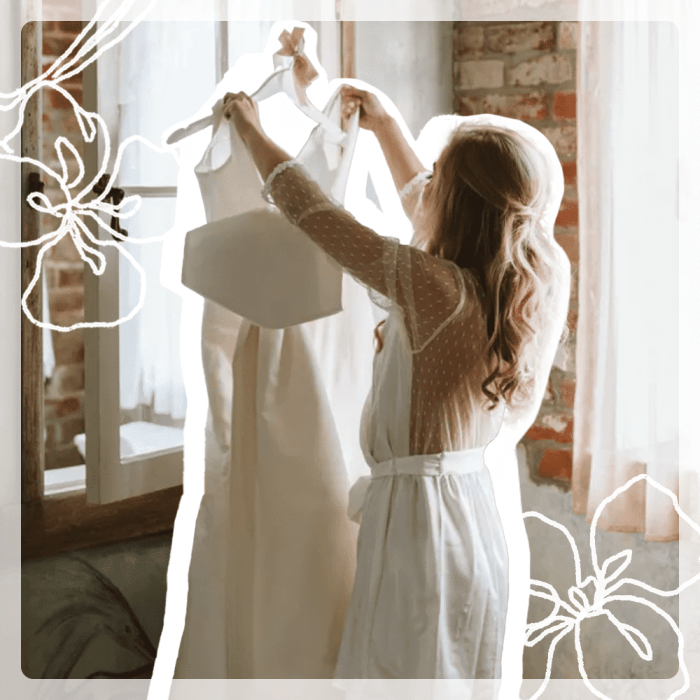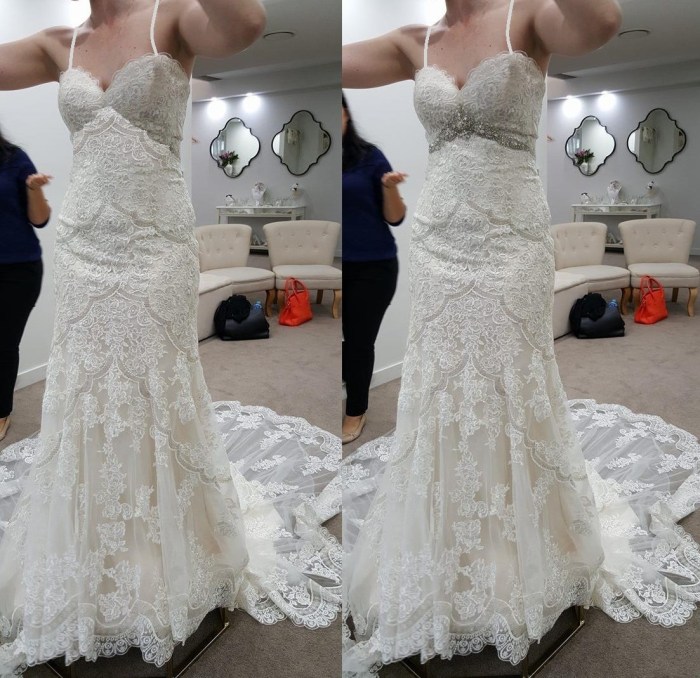Wedding Dress Alteration Costs: A Comprehensive Guide
Wedding dress alterations cost – The cost of wedding dress alterations can significantly impact your overall budget. Understanding the factors that influence these costs, common alterations and their prices, and how to find a qualified professional are crucial for a smooth and financially responsible process. This guide provides a detailed breakdown of these aspects to help you navigate the world of wedding dress alterations with confidence.
Factors Influencing Wedding Dress Alteration Costs

Source: brides.com
Wedding dress alterations can be a significant, often unforeseen, expense. The cost can vary wildly depending on the complexity of the adjustments needed, especially if you’re working with a delicate fabric like that found on a vintage long sleeve wedding dress. Remember to factor in these costs early in your planning to avoid unpleasant surprises; the last thing you need is a financial ripple effect on your big day.
Several factors contribute to the final cost of altering a wedding dress. These range from the dress’s complexity and fabric to the seamstress’s expertise and the urgency of the request.
Dress complexity plays a significant role. Intricate beading, embroidery, or layers of fabric require more time and skill, increasing the cost. Similarly, the fabric type influences the price; delicate fabrics like lace or silk demand more careful handling and specialized techniques, thus costing more than sturdier materials. Labor costs vary depending on the type and extent of alterations. Simple hemming is less expensive than extensive restructuring or adding intricate details.
Rush orders and specialized alterations, such as adding beading or embroidery, incur additional charges due to the increased workload and time constraints.
| Style | Average Cost Range | Typical Alterations Needed | Factors Affecting Cost |
|---|---|---|---|
| A-line | $200 – $500 | Hemming, bustle addition, minor adjustments to bodice | Fabric type, complexity of embellishments |
| Ballgown | $300 – $800 | Hemming, bustle addition, significant bodice adjustments, potential alterations to train | Fabric type, number of layers, train length |
| Mermaid | $350 – $700 | Hemming, significant bodice adjustments, potential alterations to fit curves | Fabric type, complexity of fit adjustments |
| Sheath | $150 – $400 | Hemming, minor bodice adjustments | Fabric type, minor alterations needed |
Common Wedding Dress Alterations and Their Costs, Wedding dress alterations cost
Typical alterations include hemming, taking in the bodice, altering straps, and adding bustles. The cost varies greatly depending on the complexity of the alteration. Simple hemming typically falls within a lower price range, while more complex alterations, such as extensive restructuring or intricate beadwork, command higher fees.
- Low Cost: Hemming ($50-$150), minor strap adjustments ($25-$75)
- Medium Cost: Taking in the bodice ($100-$300), adding a bustle ($100-$250)
- High Cost: Extensive restructuring ($300+), adding sleeves or significant alterations to the train ($200-$500+), intricate beadwork or embroidery repairs ($100+ per hour)
Finding a Qualified Seamstress or Tailor
Selecting a reputable professional is crucial for ensuring the quality and longevity of your wedding dress alterations. Experienced seamstresses specializing in bridal wear possess the skills and knowledge to handle delicate fabrics and intricate designs. Pricing structures vary; some charge hourly rates, while others offer per-alteration fees. Be wary of excessively low prices, as they may indicate a lack of experience or quality.
Before committing, ask about their experience with bridal alterations, request references, and review their portfolio. Inquire about their pricing structure, turnaround time, and their process for handling potential issues.
- Check their reviews and references.
- View their portfolio of past work.
- Discuss their experience with your specific dress style and fabric.
- Get a detailed written estimate.
Budgeting for Wedding Dress Alterations

Source: weddingbee.com
Including alteration costs in your wedding budget is essential for avoiding unexpected expenses. Accurate estimation involves consulting with a seamstress or tailor to get a detailed quote after a fitting. To save money, consider prioritizing essential alterations, choosing simpler designs, and opting for less expensive fabrics. Negotiating prices is possible, but it’s important to be respectful and understanding of the seamstress’s time and expertise.
Consider setting aside a contingency fund to cover unforeseen costs or adjustments.
Visual Guide to Wedding Dress Alterations
The process of hemming a wedding dress involves carefully measuring the desired length, marking the hemline, and then using a serger or other appropriate stitching method to create a clean, even finish. Taking in a wedding dress bodice requires precise measurements and adjustments to the seams to achieve a snug, flattering fit. Altering straps might involve shortening, lengthening, or repositioning them for a comfortable and visually appealing result.
Adding a bustle involves attaching a system of hooks and loops or other mechanisms to the back of the dress, allowing the train to be elegantly lifted for dancing or other activities. Each alteration involves careful consideration of the fabric type, design details, and desired outcome, with before-and-after visual effects that dramatically transform the fit and appearance of the dress.
Common Queries: Wedding Dress Alterations Cost
What is the average cost of basic wedding dress alterations?
Basic alterations like hemming and taking in the seams typically range from $100 to $500, depending on the dress and the seamstress.
Can I get alterations done at a department store?
Yes, some department stores offer alteration services, but they may not specialize in bridal wear and might charge higher prices.
How far in advance should I schedule alterations?
Ideally, schedule alterations at least 6-8 weeks before your wedding to allow ample time for fittings and adjustments.
What happens if I gain or lose weight before the wedding?
Most seamstresses can make minor adjustments closer to the wedding date, but significant weight changes may require additional alterations and costs.
What should I bring to my first alteration appointment?
Bring your wedding dress, undergarments you plan to wear on your wedding day, and your wedding shoes.
